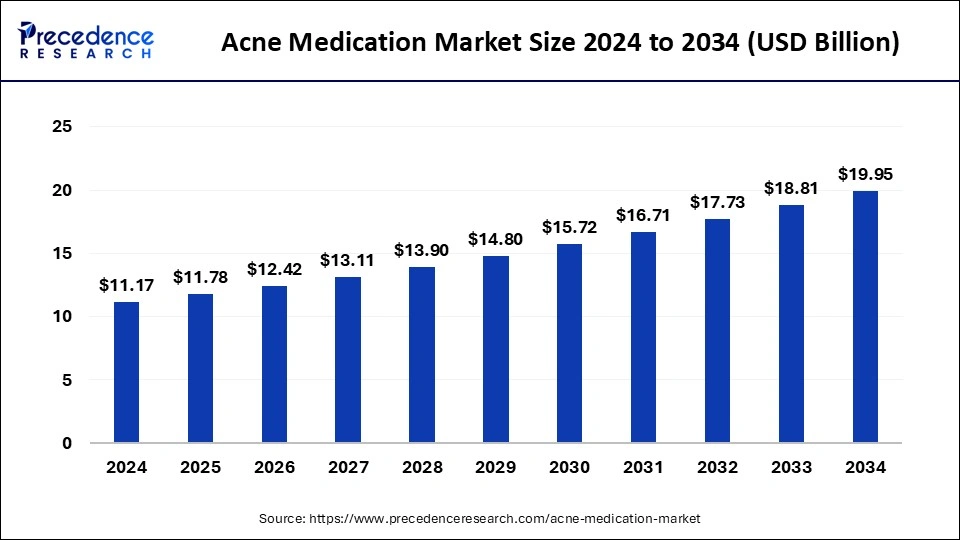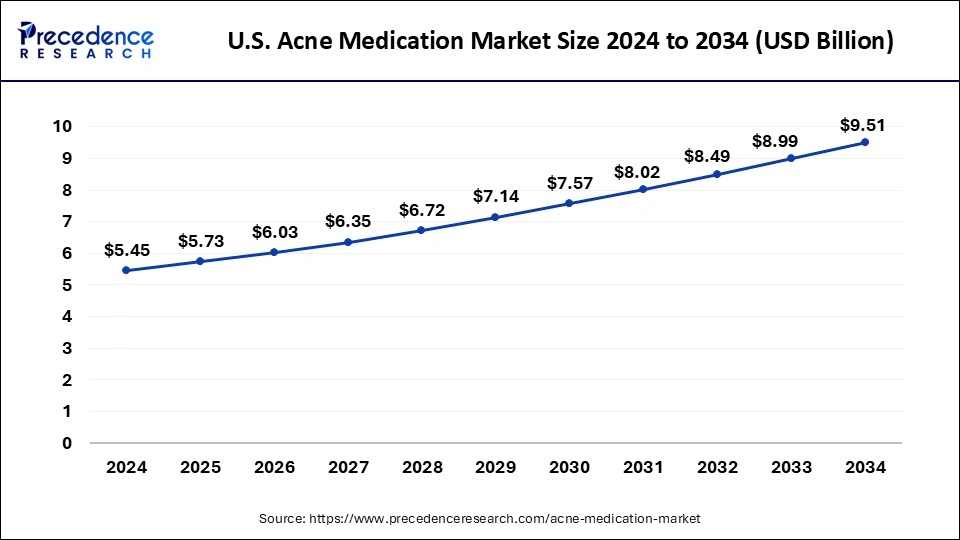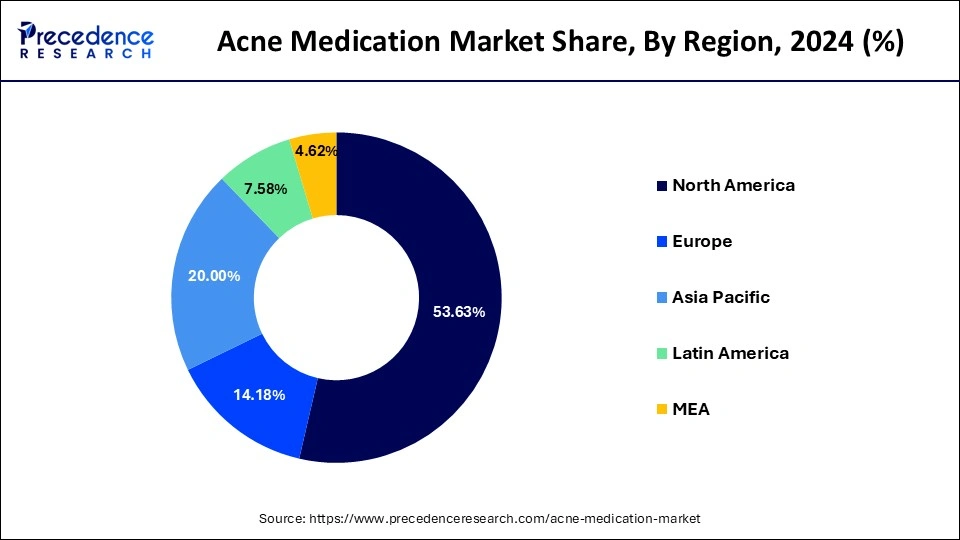March 2025
The global acne medication market size accounted for USD 11.78 billion in 2025 and is forecasted to hit around USD 19.95 billion by 2034, representing a CAGR of 6.00% from 2025 to 2034. The North America market size was estimated at USD 5.99 billion in 2024 and is expanding at a CAGR of 5.90% during the forecast period. The market sizing and forecasts are revenue-based (USD Million/Billion), with 2024 as the base year.
The global acne medication market size accounted for USD 11.17 billion in 2024 and is predicted to increase from USD 11.78 billion in 2025 to approximately USD 19.95 billion by 2034, expanding at a CAGR of 6.00% from 2025 to 2034.

The U.S. acne medication market size was exhibited at USD 5.45 billion in 2024 and is projected to be worth around USD 9.51 billion by 2034, growing at a CAGR of 5.80% from 2025 to 2034.

North America led the market with the biggest market share of 53.63% in 2024. The region’s expansion in the market is increasing due to the rising availability of the major beauty and skincare brands and the manufacturing industries in the United States and Canada. The rising investments in skincare products due to the intensive demand from the consumer are highly contributing to the growth of the market. The increase in the younger population, which is more likely to get affected by acne due to changing hormones, lifestyle, etc., is creating a significant growth in the sale of acne medication around the region, which accelerates the growth of the market across the region.

Asia Pacific is expected to witness the fastest rate of expansion in the acne medication market during the forecast period. The increasing population and majorly the younger population in India, China, and Japan are driving the demand for acne medication. The younger population, like teenagers and adults, are more likely to get acne due to lifestyle, urbanization, and rising pollution, which is highly impacting human health and skin and boosts the growth of the acne medication market. Additionally, the rising expenditure on healthcare and appearance is collectively contributing to the growth of the market.
The Asia Pacific acne medication market offers a wide range of products catering to various skin types, concerns, and preferences. From traditional herbal remedies to modern pharmaceutical formulations, consumers have access to a diverse array of acne treatment options, contributing to market dominance. Improvements in healthcare infrastructure, access to healthcare services, and availability of over-the-counter (OTC) acne medications contribute to market expansion in Asia Pacific. As healthcare systems become more accessible and healthcare professionals promote skincare awareness, individuals are more likely to seek treatment for acne.
The acne medication market refers to the pharmaceutical and over-the-counter (OTC) products designed to treat and manage acne, a common skin condition characterized by the presence of pimples, blackheads, whiteheads, and inflammation on the skin. Acne medications encompass a wide range of topical and oral treatments, including prescription medications, over-the-counter creams and gels, cleansers, and spot treatments.
Adapalene is one of the types of medication that is used in the treatment of acne problems. It comes in a gel or cream formulation. Benzoyl peroxide is another type of acne medication that destroys or reduces the amount of bacteria in acne. Changing lifestyles, sleeping and eating habits, higher consumption of junk and oily food, rising environmental pollution, and bad weather conditions are collectively impacting human health and skin, which results in increasing skin diseases like acne that boost the demand for acne medication and drive the growth of the acne medication market.
| Report Coverage | Details |
| Growth Rate from 2025 to 2034 | CAGR of 6.00% |
| Market Size in 2025 | USD 11.78 Billion |
| Market Size by 2034 | USD 19.95 Billion |
| Base Year | 2024 |
| Forecast Period | 2025 to 2034 |
| Segments Covered | Product, Routes of Administration, Age-Group, and Distribution Channel |
| Regions Covered | North America, Europe, Asia-Pacific, Latin America, and Middle East & Africa |
The rising cases of acne in the younger population
The rising cases of acne in the younger population, mostly teenagers, are driving the growth of the acne medication market. The increasing urbanization and, changing lifestyles, and increasing pollution levels are highly impacting the skin of humans and causing allergies, pimples, blackheads, which are driving the demand for effective medication for the treatment of such conditions, which is driving the growth of the market. Additionally, the rising availability and the innovative launch of the latest treatment products, such as retinoids, antibiotics, and others, are influencing the growth of the market.
Side effects
Similar to several other medications prescribed for cosmetic and medical use, acne medications result in a wide range of adverse reactions ranging from mild local irritation to systemic side effects such as liver dysfunctions. Depending on individual cases has been reported wherein side effects such as vomiting, nausea, or diarrhea were reported on the use of acne medication. This can hamper the growth of the acne medication market.
Increasing investment in skin and beauty products
The increasing demand for maintaining facial aesthetics in the population is driving the growth of major beauty and personal care companies that make lifestyle products for the generation that faces skin challenges like acne, pimples, dull skin, blackheads, etc. The increase in the beauty industry and the rising expenditure on skin treatment and maintenance are boosting the growth of the market. The increasing investments in research and development programs for the innovation of new products or treatments associated with acne are driving future opportunities for the acne medication market.
The antibiotics segment dominated the acne medication market in 2024. The rising adoption of antibiotics as a treatment for acne due to their higher efficiency is drives the growth of the antibiotics segment. Antibiotics come in two types: topical and oral. Antibiotics are highly used in acne treatment because they help to reduce the amount of bacteria, inflammation, and swelling and minimize the risk of scars. Tetracycline and erythromycin are antibiotics that can help reduce the extreme pain of acne, which is related to bacteria on the skin. Thus, the higher adoption of antibiotics in acne treatment drives the growth of the antibiotics segment.
The retinoid segment is expected to grow at a notable rate in the acne medication market during the forecast period. The growth of the segment is expected to increase due to the rising demand for retinoids to help reduce mild acne and enhance the skin's appearance. Retinol generally comes in gels, serums, lotions, wipes, and creams. Retinol is commonly found in every kind of skincare product, including anti-acne and anti-aging products. Retinol is applied to the skin once per day after cleaning the face for 20 or 30 minutes. There are some other benefits associated with the use of retinol, such as anti-aging, minimizing fine lines and wrinkles, reducing pigmentation, increasing skin elasticity, and enhancing skin tone and texture. All these factors are contributing to the demand for retinol in the acne medication market.
The topical segment held the largest share of the acne medication market in 2024. The growth of the segment is attributed to the rising adoption of topical solutions due to their easy availability and soothing nature. Topical retinoids like adapalene or tretinoin are considered the most effective method for the treatment of comedonal acne. Topical antibiotics like azelaic acid and benzoyl peroxide are used in the inflammatory condition of acne. Topical treatments are considered the sole treatment for acne in many patients and are used as part of the therapeutic regimen.
The oral segment is expected to grow at the fastest pace in the acne medication market during the anticipated period. The rising adoption of oral administration of acne medication due to its effectiveness and treatment within the body is driving the demand for the oral administration of the drug. Oral medicine is prescribed by the doctor in the case of moderate to severe acne problems, and acne does not respond to the topical treatment. The segment includes oral antibiotics, accutane (isotretinoin), oral contraceptives, and Aldactone (spironolactone). In which oral contraceptives and Aldactone are used in acne related to the menstrual cycles.
The retail and online segment is expected to witness a significant rise in the acne medication market during the forecast period. The growth of the segment is attributed to the rising adoption of online marketing by consumers due to better discount offers, convenience, and other benefits. The rising e-commerce platforms like Amazon, Walmart, etc., and the rising commercialization are boosting the growth of the segment. Additionally, the rise in urbanization and the increasing number of supermarkets and hypermarkets in urban areas are contributing to the expansion of the retail sector and fueling the growth of the market.
By Formulation
By Product
By Type
By Acne Type
By Distribution Channel
By Geography
For inquiries regarding discounts, bulk purchases, or customization requests, please contact us at sales@precedenceresearch.com
No cookie-cutter, only authentic analysis – take the 1st step to become a Precedence Research client
March 2025
March 2025